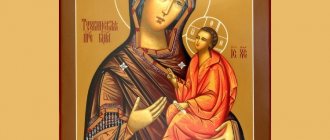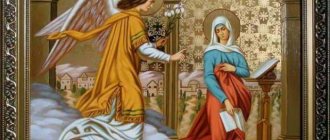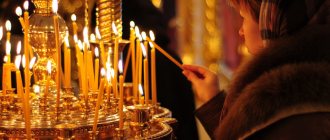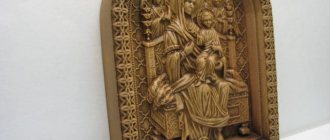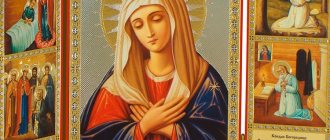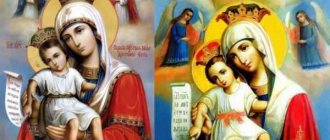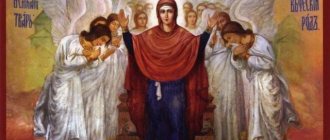New Russian holiday
Since 2005, November 4 has been celebrated in Russia not only as an Orthodox holiday, but also as a civil holiday, called National Unity Day. This is one of the days of military glory. It symbolizes the unification of the country. On this day the Church celebrates the memory of the Moscow Kazan Icon.
Iconography: Kazan Icon of the Mother of God Material: Wood, tempera Icon dimensions: height 32 cm, width 27.5 cm Shoulder-shaped image of the Mother of God with the Child. © Samara Regional Art Museum
Day of the Kazan Icon of the Mother of God in 2021: history and traditions of the holiday
The celebration takes place twice a year: on the day of the discovery of the icon and on the day of the liberation of Moscow from the Poles.
Day of Our Lady of Kazan - November 4
The holiday dates back to the 17th century, when Tsar Mikhail Fedorovich issued a decree with the support of Moscow Patriarch Philaret on the annual celebration of the established date - October 22 (November 4, new style).
Petersburg copy of the Kazan Icon of the Mother of God, located in the Kazan Cathedral
On November 4, a holiday was established in honor of the expulsion of the Poles from Moscow. According to legend, Prince Dmitry Pozharsky prayed long and earnestly before the battle before the icon of the Kazan Mother of God. As a result, the Russian army drove out the invaders, and the image began to be revered with even greater love.
On this day it was customary to perform religious processions after the Liturgy. Nowadays, they are performed along the main streets of cities or around the temple.
About the days of veneration of other icons:
- Feast of the Iveron Icon of the Mother of God
- On the veneration of ancient Orthodox icons
Summer holiday of the icon of the Kazan Mother of God on July 21
On this day it is customary to celebrate the discovery of a shrine on Kazan soil. Believers come to church for services to honor the Mother of God and ask for her protection and help in pressing matters.
Orthodox celebration traditions
The holiday of the “autumn” icon of Our Lady of Kazan is approaching. And in anticipation of it, many converts are wondering how to properly spend this day.
- First of all, you should attend the church holiday service and attend the Liturgy. At the end, you can pray for your family and ask for health for everyone. It is also customary on the day of the icon of Our Lady of Kazan to ask for peace on earth.
- Usually on a holiday, a solemn service is performed in churches with the glorification of the name of the Mother of God. The priest gives instructions to the parishioners, reminding them that the Blessed Virgin Mary is an intercessor before the Lord for the entire human race. Through her prayers one can be worthy of the grace of God.
- There are congratulations on the fact that the Orthodox people have found a reliable protector in the person of the Mother of the Lord, and the appearance of her holy images is a direct confirmation of this.
List of the Kazan Icon of the Mother of God in the Kazan Cathedral on Red Square (Moscow)
There are no special instructions from the church. But the laity are of the opinion that on this holiday you should not engage in heavy physical work.
Advice! It is better to devote the day to communicating with loved ones and thinking about your life. After all, in the bustle of everyday affairs, people often do not have enough time for solitude, in which they can think about what is happening and look into their own soul.
Church Militant
The history of relations between Moscow and Kazan was complex. The Kazan Khanate was once part of the Mongol Empire, the Golden Horde, then an independent state. There were Tatar raids, attempts by Russian princes to peacefully resolve matters with the khans, and military clashes. More than once the Moscow Grand Dukes tried to conquer the Khanate. But this was not an easy task, the fortress was strong and the Tatar warriors were skillful.
In 1552, the young Tsar, Ivan IV, began the campaign against Kazan. This campaign was unusual: crosses and banners were carried in front of the troops, prayers were performed. And the Lord did not disgrace those who hoped in Him: Russian troops took Kazan. They say that the night before the capture of the city, Ivan Vasilyevich heard the bells of the Moscow “forty forties” - thousands of miles from the capital...
But on the Kazan land, taken by the power of God, Orthodoxy spread with difficulty. Islam was strong, many were dissatisfied with the new faith, unprecedented in these lands. Several Kazan martyrs are known from the church calendar who died in those early years for their faith.
Folk signs
Folk signs during the summer celebration of the Kazan Mother of God apply to the weather for the rest of the summer, the beginning of ripening and harvesting, after July 21:
- the weather became hot, the rye ripened and the harvest began;
- Cherries and blueberries ripened, jam was made from the berries;
- black milk mushrooms appeared, they were collected and salted for the winter;
- rain that day foreshadowed prolonged bad weather;
- a sunny day before lunch predicted hot weather until mid-August;
- The birth of the month with a ladle down was predicted by dry August.
Appearance of the image
In July 1579, Kazan caught fire. There was a blaze at the Church of St. Nicholas, in the courtyard of archer Danila Onuchin. The fire spread to other houses, then to neighboring streets. The city burned so much that in a few hours almost the entire Kremlin and the best city blocks burned out. The Mohammedans said that the fire was a manifestation of the wrath of the “Russian God” against the Orthodox.
The day of finding the Shrine in the depths of the earth
It was then that Danila Onuchina’s daughter suddenly began day after day to tell her parents that she had seen in a dream vision an icon of the Mother of God, shining with a light brighter than the sun. The Most Pure One commanded her to find Her image at the conflagration, even indicating the place. The parents, upset, busy rescuing their meager belongings and restoring the house, did not listen to their daughter once or twice.
Useful materials
And Matrona was already crying: in Her third appearance, the Mother of God commanded that Her image be found with threats.
With horror, the young woman even fell to the ground, “as if she were dead, and lay on the ground for many hours,” as the “Tale” tells about the appearance of the icon.
Finally, the girl’s mother went to the archbishop. But the bishop did not heed the child’s words. Then the woman, not listening to the arguments of her husband and relatives, took up the shovel. Several more people joined her.
8
July
1579
At a depth of about 1 m, the icon of the Mother of God was found only when Matrona joined the search. The image was wrapped in an old rag, like a sleeve from a man's caftan, but the image itself was clean, bright, as if painted recently. Who hid the shrine and why? Was it not a secret Christian who feared for the icon in Mohammedan Kazan? All this remained unknown. It is only clear that through this image the Most Pure One wanted to show Her grace.
Folk and Orthodox traditions
The Orthodox have preserved the folk traditions of celebrating the Kazan Mother of God. There are certain rules for allowing and prohibiting actions. It is not recommended to do heavy work on holidays. Church canons prescribe attending morning, afternoon or evening services in church and turning the believers in prayer to God and the Mother of God with gratitude, honoring them for their good deeds.
Clergymen are allowed to work (if necessary) after praying or attending church. In the old days, young people organized festivities and celebrations in nature.
To this day, legends have been preserved about the infliction of physical injuries and material damage due to non-compliance with the rules of conduct on church holidays. So, while mowing, a storm with lightning suddenly struck, burning the owner’s buildings. Women did not go to the river to wash clothes, for fear of being dragged into the pool by the Vodyanoy.
Nowadays, when doing household work on Orthodox holidays, people are faced with equipment breakdowns and minor injuries in the form of bruises, cuts, and burns. With an icon depicting the Kazan Mother of God, parents bless the newlyweds for a long, happy life.
First miracles
Realizing the miracle taking place, the archbishop ordered the bells to be rung. He blessed the priest Ermolai (the future Patriarch Ermogen) to take the image from the nearby St. Nicholas Church.
Kazan Icon of the Mother of God
Here, with a large crowd of people, the first prayer service was served in front of the newfound shrine. Then a procession with the image moved around Kazan. The news about the newly-minted icon spread quickly. There were so many people that “they trampled on each other, and some walked on their heads, touching the miraculous image of the crown of their head.”
Among the pressing crowd of people, Father Ermolai slowly moved with the holy image. It seemed to him a miracle that he was not crushed or crushed by a huge crowd. But “he carried away all creation, and the One who gave birth to the most wonderful and miraculous icon,” as he would write later, when he was already Metropolitan of Kazan.
Then, during the procession, the first miracle happened - a blind beggar, a certain Joseph, “who had not seen the least of his eyes,” received his sight. However, instead of giving thanks for the healing, this beggar strives even more intensely to ask for silver.
The ungrateful one immediately suffered from his previous illness, and only a small amount of vision was left to him. But another blind man, Nikita, who received his sight at the same time, publicly thanked the Lord and the Most Pure One. In total, the “Tale” about the appearance of the icon records 16 of its miracles that took place in the city of Kazan - helping the blind, those with sick legs, and the paralytic.
Interesting fact
A list of the image and a story about miracles were then sent to Ivan IV. By his order, a convent was erected where the icon appeared. Among his 40 nuns, one of the first were Matrona and her mother, who completely changed their lives after the miracle took place.
Miracles of the Icon of Our Lady of Kazan
In the temple books there are many records of clergy about cases of miraculous healing of the sick.
- So, one of the stories tells that a certain man named Nikita could not see for three years. He fell to the icon with fervent prayer and received his sight. After standing at the prayer service, he returned home with great joy, glorifying the name of Christ and the Most Pure Virgin Mary.
- The story of the baby's epiphany is especially touching. The mother brought her child to the temple and prayed for a long time with him in her arms at the image of the Virgin Mary. When those present noticed how the baby began to touch his mother's face, an apple was held in front of his face. The child reached out to him and everyone realized that the baby had received his sight.
- There is a known case when, by the grace of the Mother of God, a young man who suffered from relaxation received healing. He could not move his limbs, which caused a lot of suffering. Having learned about the miraculous icon, the guy, whose name was Isaac, asked his mother to serve a prayer service in front of the icon. At home, he constantly asked the Mother of God to give him the opportunity to see the shrine with his own eyes. Suddenly the guy felt relieved and was even able to get to his feet. Taking two clubs, he headed to the monastery where the image resided, and together with his mother fell to the face, thanking for the help.
There is so much more that could be listed.
Important! The mercy of the Lord and the Virgin Mary is limitless. Thousands of people who visited the image of the Kazan Mother of God were convinced of this.
"Hodegetria" of Siberian pioneers
What did the appearance of the icon signify? Then it seemed to everyone that, first of all, the establishment of Orthodoxy in the newly conquered city. But not only. Soon the first detachments of military people moved from here to conquer Siberia.
The blessing of the Mother of God accompanied the first campaign of the Cossacks of Ataman Ermak to Siberia. According to some sources, the campaign began in the year the icon appeared, according to others - two years later.
In any case, the Kazan Icon became the “Hodegetria” of the Russian pioneers of Siberia. The Cossacks took her lists with them. Within a few years, churches consecrated in honor of “Mother of Kazan” appeared on Siberian soil.
It soon turned out that the appearance of the icon was not only a blessing of Orthodoxy in the lands of the Volga region and Siberia. Russia especially needed the prayerful intercession of the Mother of God.
Old Believer churches in honor of the Kazan Icon of the Mother of God
Twice a year, in summer and autumn, ceremonial services are held in Old Believer churches. Many of them were consecrated in honor of this holiday. First of all, these are the Belokrinitskaya, Pomorskaya and Fedoseevskaya communities of Kazan.
Church of the Russian Orthodox Church in honor of the Kazan Icon of the Mother of God. Kazan
Patronal feast day today in the communities of the Russian Orthodox Old Believer Church in Samara, Biysk, the villages of Slobodishche and Gubino in the Moscow region, the villages of Bolshoye Nepryakhino, Bezvodnoye, Fedurino in the Nizhny Novgorod region, the village of Pustyn in the Kostroma region, the village of Primorskoye in the Odessa region and other cities and villages of Russia, Ukraine and Romania . In two monasteries of Belokrinitsky consent, today is also a patronal holiday: in the village of Kunicha (Moldova) and the village of Russkaya Slava (Romania).
Temple of the Kazan Icon of the Mother of God. Slobodishche (Moscow region)
Temple in the name of the Kazan Icon of the Blessed Virgin Mary of the Old Believer Convent in the village. Kunicha (Moldova)
Temple of the Kazan Blessed Virgin Mary. Primorskoe (Odessa region)
The patronal holiday is for the temple and monastery of the Russian Ancient Orthodox Church in the village of Filippovskoye, Nizhny Novgorod region (Malinovsky monastery) and in the Pomeranian communities of Samara, Barnaul, Naryan-Mar, Rybinsk, the city of Novograd-Volynsky, Zhitomir region (Ukraine) and the city of Bobruisk (Belarus).
Kazan Church of the Russian Children's Center in the village of Filippovskoye, Nizhny Novgorod region
Liberator of Moscow
Ivan IV, starting with the brilliant capture of Kazan and Astrakhan, ended his reign with an inglorious defeat in the Livonian War, in a country devastated by the oprichnina.
And soon after his death the dynasty was completely interrupted. Russia has lost its Tsar, God’s anointed. A few years later, Polish and Swedish invaders came to the country. Impostors and intriguers replace each other on the royal throne. It’s not like there’s a legitimate tsar—there’s almost no power in Holy Rus' anymore.
By this time, the priest Ermolai had long since taken monastic vows. He managed to live in Moscow and in 1589 returned to Kazan as a metropolitan. In 1594, through his efforts, the stone Kazan Cathedral was built. In 1606, Metropolitan Ermogen became Patriarch.
Hieromartyr Hermogenes
Patriarchate of St. Hermogenes fell during the most terrible years of the Troubles. On the empty royal throne, impostors, adventurers, and unprincipled politicians replaced each other. Finally, the boyars decided to invite a non-Christian to the kingdom - the Polish prince Vladislav.
Iconography: Kazan Icon of the Mother of God Dates: XVII century. Second quarter of the 17th century. Origin: From the Spaso-Prilutsky Monastery near Vologda. Material: Wood, gesso, tempera Icon dimensions: height 37.5 cm, width 32 cm Icon in frame. In the middle there is a depiction of the Mother of God and Child. In the margins are images of Saints Gurias and Barsanuphius. VOKM 5474 ©Vologda State Historical, Architectural and Art Museum-Reserve
There was only one thing left to do - a blessing to the new Tsar from the Patriarch of All Rus'. But the saint demanded that Vladislav accept Orthodoxy. Without this condition, I did not give the blessing. Arrested by traitors, already dying of hunger in the dungeons, the elderly patriarch wrote to the Cossacks, archers, and townspeople of Nizhny Novgorod, asking them to stand for the “house of the Most Pure One,” Rus', “to cease robbery, to preserve brotherhood.”
The first militia for the liberation of Moscow gathered with the blessing of the patriarch in the summer of 1611. Apparently, Ermogen blessed Metropolitan Ephraim of Kazan to send a list of icons with the priest of the Annunciation Cathedral - for the troops. This was the last message of the saint - he soon died.
Two militias
Tradition testifies that the militia greeted the shrine without much respect. And soon the leaders of the army quarreled, one of its leaders, Prokopiy Lyapunov, was killed. The attempt to take Moscow on our own failed; people rejected the help of the Mother of God.
The priest with the icon had to return with sorrow to its place of residence. But, having reached Nizhny Novgorod, the priest, the keeper of the shrine, met... the newly assembled army under the leadership of Prince Dimitri Pozharsky. The militia and the prince asked to leave the shrine to them for the blessing of the campaign.
By that time it was already known about the death of St. Hermogenes in captivity. Rus' has only one hope left - in the Most Pure Mother of God. So, with the Kazan Icon, the second militia began a campaign against Moscow.
“Judgment will be turned over to mercy”
At this time, in the Moscow Kremlin occupied by the Poles, another holy martyr, the Greek Archbishop Arseny, was languishing in prison. From the hardships of imprisonment he was sick, approaching death. With him was another copy of the image - apparently, the one that was once made for Tsar Ivan IV.
Tradition says that Arseny, despite his illness, spent three days in front of the icon in constant prayer, asking the Lady to have mercy on Orthodox Rus'. On the third day, light shone in the wretched dungeon. The person praying suddenly saw a monk, whom he recognized as St. Sergius of Radonezh. “Arseny, our prayers have been heard; - said the monk, - through the intercession of the Mother of God, God’s judgment on the Fatherland was transferred to mercy; "Tomorrow Moscow will be in the hands of the besiegers and Russia will be saved."
When the bishop came to his senses, he suddenly realized that his illness had completely passed, as if to confirm that the revelation he had received would be fulfilled. It was October 21, 1612. And in the morning of the next day, the troops led by “Mother of Kazan” began their offensive. After another 2 days, the last invaders left the Russian capital - Moscow accepted congratulations!
25
October
1612
The people's militia entered the Kremlin without noise or triumph. It was not a procession of victors, but a procession of the cross in the presentation of the image of the Mother of God.
And towards him “he carried the whole creation, and the one who gave birth to a wonderful and miraculous icon,” Bishop Arseny. This is how two icons of the Lady met. People fell to their knees with tears... Thus Moscow was liberated. A new life has begun for the country.
Earthly gratitude to the heavenly helper
First of all, the copy from the newly found icon was sent to Ivan the Terrible. He became the first, laying the foundation for subsequent numerous lists of the Icon of the Kazan Mother of God.
Having learned about such a happy event, Ivan 4 ordered the construction of a new large monastery on this site, in which 40 nuns would live. Among them was Matryona and her mother. And the Image itself was surrounded by gold, pearls and other precious stones.
After 2 centuries, Catherine II, the Russian Empress, ordered a new frame to be made for the Kazan Icon, which was decorated with her own crown with diamonds.
And in 1798, especially for the Kazan Icon of the Mother of God, construction began on another majestic cathedral, which, unfortunately, after more than 100 years was destroyed along with the entire monastery. But by this time the icon had not been there for a long time: it had been stolen.
Intercessor of Russia
In subsequent centuries, the miracles of the image are innumerable. Miracles flowed like a river from the image kept in Kazan and hundreds of copies that spread throughout the cities and villages. Tradition has preserved only the most glorious of thousands of miraculous signs.
Poltava battle
In 1709, a priest from the Ukrainian village of Kaplunovka gave Peter I the list of Kazan, miraculously revealed to him. After the prayer of the entire army led by the tsar, the battle, which lasted less than 2 hours, ended in a brilliant victory for the Russian army.
Defeat of Napoleon
On October 22, 1812, the detachment of General Miloradovich and the ataman of the Donskoy Platov army almost destroyed the rearguard of Napoleonic Marshal Davout. Enemy losses amounted to 7,000 people. Among the Cossacks there was a list of the Kazan Icon. That same day it got cold unusually early and it started snowing. This was the beginning of a disaster for Napoleonic troops.
Icon of Our Lady of Kazan depicting miracles
In memory of the intercession of Mother Kazan, the Kazan Cathedral was built in St. Petersburg. Its idea arose under Peter I, and construction began in 1810. After the events of 1812, the cathedral became a monument to the “thunderstorm of the twelfth year.” Its iconostasis is made from 100 pounds of captured silver donated by the Don Cossack army. Napoleon's winner, Field Marshal M.I. Kutuzov, is buried in the cathedral.
In the temple there is a list of the image, which was delivered to St. Petersburg back in 1721, by order of Peter I.
Miracles during the Great Patriotic War
Since the 1990s There is a legend in circulation according to which Metropolitan Elijah of the Lebanese Mountains in 1941 took upon himself the feat of prayer for Rus', similar to the feat of St. Arsenia, praying for three days before the icon of the Mother of God. According to this legend, Elijah received a revelation from the Most Pure One. She ordered the opening of churches in Russia, the release of arrested priests, and the encircling of Her Kazan image in a religious procession around besieged Leningrad. This message was allegedly conveyed to Metropolitan. Elijah personally to Stalin. Stalin, a former seminarian, fulfilled the command of the Mother of God with precision.
Modern church historians, however, do not confirm the authenticity of this story. No documents have been preserved regarding the Metropolitan’s contacts with the government of the USSR; there is only information about his visit to the Soviet Union after the war, in 1947.
However, the fact that closed churches were opened at the beginning of the war is quite real. The special role of the Kazan Icon in the defense of Leningrad is confirmed by documents. Processions of the cross took place with her.
There is more evidence of other miracles of the Kazan icon during the war related to the healing of wounded soldiers and the preservation of life in battle.
The history of the miraculous appearance of the icon of the Virgin Mary
The discovery of a miraculous image took place in the city of Kazan at the end of the 16th century. At that time, the indigenous population professed mainly Islam, but there were also pagans. The spread of Orthodoxy among people was very difficult. But one case reversed the existing trend.
There was a big fire. A third of the city burned to the ground. Many human lives were claimed by the fire element. There was schadenfreude from opponents of the Christian faith. It was rumored that this was a sign of the incorrectness of Orthodoxy. However, later even the Tatars believed in Christ.
First discovery of an icon
A nine-year-old girl named Matrona, who lived in the city, had a strange dream. A woman resembling the Mother of God appeared to her and told her to find the icon buried in the place of the burnt house. The next morning Matrona told her parents about everything. But no one paid much attention to this. You never know what a child could dream about. Nevertheless, the dream repeated itself two more times. The frightened girl asked her mother to go with her to the place indicated by the Virgin Mary, and they actually unearthed an icon with the face of the Virgin Mary. It is surprising that it was absolutely intact; the fire did not cause any harm to the image.
Kazan Icon of the Mother of God
The event occurred on July 21st. This day has become a holiday in the Orthodox world. Even today, historians cannot give an exact answer as to where the icon came from underground at the site of the burnt hut. It is assumed that confessors of Christianity could have hidden it, protecting the shrine from the oppressors of the Orthodox religion.
The news of the miraculous icon spread quickly. Representatives of the clergy, led by Archbishop Jeremiah, arrived at the place where she was found. The image was solemnly placed in the parish church of St. Nicholas of Tula. The list of the image of the Mother of God was sent to Moscow, and a letter was also attached to it describing the miracles that happened with the discovery of the icon.
Tsar Ivan the Terrible ordered the construction of a temple in honor of the Kazan Icon of the Mother of God on the spot where the shrine was found. It was into it that the image was subsequently transferred. A little later, a convent was also erected. There, according to historical information, Matrona and her mother took monastic vows.
On a note! When the icon was in the St. Nicholas Church, the first prayer service was served before it by Father Ermogen, who soon became patriarch. He became the author of a book in which he described with great accuracy all the miracles that happened at the holy image, of which he was an eyewitness.
The meaning of the icon in history
Many important historical events are associated with the icon of Our Lady of Kazan. She is credited with helping to expel the Polish invaders from Moscow.
About other icons of the Virgin Mary:
- "The Unbreakable Wall"
- "Desperate One Hope"
- "Kasperovskaya"
During the war with the French, the entire Russian army asked for protection and intercession from the icon. The result is known - Napoleonic army began to retreat and suffered heavy human losses. Therefore, of all the known images, this one is especially widespread in the country’s churches, and many lay people resort to the help of the Kazan Mother of God to this day.
Autumn Day of the Kazan Icon of the Mother of God is a holiday in honor of the liberation of Moscow from the Poles in 1612
The history of the loss of the Kazan icon
Researchers believe that the original icon was transferred by Peter I to St. Petersburg. A new cathedral was erected for him by order of Emperor Paul. Before the arrival of the Bolsheviks, the icon was kept in the Kazan Cathedral. Then, as you know, persecution of the Orthodox Church and mass confiscation of valuables began. The rector of the temple did not allow the icon to be taken away in 1922. But ten years later the cathedral was closed. The iconostasis was completely dismantled, melted down and sold. Believers hid the shrine for some time in the Smolensk cemetery.
There is another version: the icon was destroyed by the thieves, and the silver frame was sold.
However, modern historians have doubts about the authenticity of the icon preserved in the cemetery church. The fact is that according to the description of Father Hermogenes, its dimensions were somewhat different. In addition, there is not a single piece of evidence from Peter I’s contemporaries who would confirm the fact that the icon was transferred to St. Petersburg. Therefore, it is impossible to say with certainty that the original icon of the Kazan Mother of God has been preserved.
Nevertheless, many copies of the famous icon were distributed among Russian churches, which also turned out to be miraculous and continue to help believers.
New discovery of the icon of the Kazan Mother of God
In 2004, a delegation from the Vatican arrived in Russia. The clergy brought a copy of the icon, which had traveled a difficult path before reaching Russian soil.
The image was one by one bought by foreign collectors, but ultimately it ended up in the residence of the Pope. The head of the Catholic Church decided to transfer the relic to the Russian Orthodox Church.
At some point, there was even an opinion that this was the very icon that our specialists were looking for. But after careful analysis and comparison with descriptions of past centuries, the conclusion was that this was a copy.
Patriarch Alexy II hands over the Kazan Icon of the Mother of God to believers
However, pilgrims again flocked to Kazan to bow their heads before the face of the Mother of God, which indicates the significance of the lists of the icon.
Original and lists of the Kazan Icon
There is no official information about where the real icon, revealed in Kazan in the 16th century, is located. Some claim that the copy of the icon was stolen, but the original remains in its homeland to this day. Others are sure that the icon was stolen in 1904 and sold abroad.
Be that as it may, the lists of the miraculous image have the same power and have helped pilgrims more than once.
Disappearance of the shrine
By the beginning of the 20th century. There were so many miraculous lists that many found it difficult to say where the first image was. However, the majority believed that he was still in Kazan.
This icon, surrounded by honor and love from the townspeople and many pilgrims, had an expensive frame and vestments decorated with precious stones. The cost of jewelry donated by grateful believers was then estimated at 100,000 rubles. This is what attracted the robbers. On June 29, 1904, at night, thieves who made their way into the Kazan Cathedral stole both the rich attire and the image itself. The kidnappers were found. The leader, a peasant, Bartholomew Chaikin, told what no one wanted to believe. He sold the jewelry, but the image itself... cut it into pieces and burned it in the stove!
However, the thief himself constantly changed his testimony, sometimes admitting the burning, sometimes denying it. Therefore, many versions arose - from the sale of the original to the Old Believers, to its hiding in one of the city churches. In any case, the original was never found.
History of the image
The history of the appearance of the icon, depicting the Mother of God and Jesus Christ in infancy, dates back to the middle of the 16th century. The Kazan Khanate was annexed to the Russian state as a result of the 3rd campaign of Ivan the Terrible in order to expand the territory in June - October 1952. From that time on, the forced baptism of the indigenous population and the eradication of Islam among the Tatars began.
The great fire of 1579 destroyed 1/3 of Kazan and claimed the lives of many citizens. A ten-year-old girl (daughter of the merchant Danila Onuchin) named Matrona had a vision three times in which the Mother of God showed her the way to the ashes of the house where the surviving icon was located with a request to find it and show it to the World. Mother and daughter fulfilled the order and dug out the holy image, preserved by the Orthodox owners, from the ashes intact.
The icon was placed in the St. Nicholas Church, where it began to show miracles of healing, fulfillment of desires, and omens. At the site of the appearance of the image, the Kazan Mother of God Convent was built, in which the image of the Mother of God was located until its disappearance (according to one version of researchers).
There is no precisely established information about the fate and location of the revealed icon. In 1904, the icon was stolen by the peasant Bartholomew Chaikin. During the investigations, he outlined versions from sale to destruction. There was a legend about the replacement of the original with a copy by a servant of the monastery and moving it to another temple, but this was not confirmed.
According to one option, the image was exported abroad. In 2004, from the Vatican to Moscow, a delegation led by the cardinal brought a list of Our Lady of Kazan (passed off as the original), which is currently located in the Kazan Mother of God Monastery. The true fate of the holy image remains unknown today.
Honored Lists
Several dozen lists of the miraculous image are known. Many of them, like the original, are also revealed and are themselves considered miraculous. Among them:
- Moscow (XVI century, copy made for Ivan IV)
- Yaroslavskaya (1588, famous for the liberation of the city from invaders in 1609)
- Kaplunovskaya (XVII century)
- Petersburg (list transferred by Peter I to the new capital in 1721)
- Tobolsk (revealed in 1661 in the first Siberian diocese, Tobolsk)
In addition, a list dating back to the 18th century was recently returned to Russia. It was bought by Russian Catholics from a private collector in the 1970s, from 1993 to 2004 it was in the Vatican from the Pope, and then given to the Russian Church. Patriarch Alexy II personally delivered the shrine to Kazan. Now it is in the revived monastery, where the original was found.
Icons
There are a large number of images from the Kazan Mother of God. They are found in simple churches and large cathedrals and are revered by Orthodox believers. The miraculous abilities of icons have more than once helped people in need to heal physical ailments, console mental anguish, punish evil and provide assistance in good deeds.
The first copy of the image was sent to Moscow to Ivan the Terrible with a description of the miracles. He is revered for his assistance to the people's militia in expelling the Polish invaders. The second historically significant list is located in St. Petersburg, from the time of Peter I. It helped believers gain spiritual strength in the fight against the French and fascist invaders.
The “Vatican” list was made in the 18th century, exported to Europe during the Great October Socialist Revolution and returned home in 2004.
All lists at different historical times had a miraculous impact on real events and human destinies. The lists of the Kazan Icon, located in the churches of the cities of Shlisselburg, Moscow (Vysoko-Petrovsky Monastery), Tabynsk (Bashkiria), Suzdal, Arzamas, Vitebsk, Vologda, have a remarkable history of creation and miracles.
Image Features
Kazan is considered one of the editions of the Hodegetria (Guide Book). The peculiarity of the image is that the Virgin Mary is depicted from the shoulders up. Therefore, experts sometimes call the icon an “abbreviated” variation of the Hodegetria.
The head of the Mother of God is slightly inclined towards the Son, who bestows blessing on those praying. On the lists are icons of the 16th-17th centuries. this blessing is two-fingered, on later ones it is the so-called nominal blessing (folded fingers form a monogram of the name of Christ).
Iconography: Kazan Icon of the Mother of God Dates: XVI century. Origin: Materials of the ethnographic expedition of the Kalinin Pedagogical Institute in the Sandovsky and Vesyegonsky districts of the Tver (Kalinin) region in 1970. Material: Wood, pavolok, gesso, tempera Dimensions of the icon: height 24 cm, width 18 cm The image of the Mother of God is shoulder-length, the head is tilted towards the Child. Maforium is dark cherry. The figure of the Child is shown upright, the image is bent. The right hand is bent at the elbow in a blessing gesture, the left hand is hidden by clothing. Inv. No. KGIAHIM KP 8654. © Kargapol State Historical, Architectural and Art Museum
Temples
In honor of the Kazan Mother of God, temples and churches were created in Rus' and in foreign countries that were named after her (more than 1800):
- Cathedral of the Kazan Icon of the Mother of God in Moscow;
- Kazan Cathedral in St. Petersburg;
- Kazan Bogoroditsky Monastery in Kazan;
- Cathedral of the Kazan Icon of the Mother of God in Yaroslavl.
Temples and cathedrals bearing the name of the Mother of God are located throughout the vastness of Russia in the cities of Gagarin, Tambov, Volgograd, Yaropolts, in the Stavropol region, in the Irkutsk and Kaliningrad regions.
All churches are operational, have historical values, they are visited by faithful parishioners, and they offer prayers to the Mother of God and Jesus Christ.
Prayer to the Most Holy Theotokos before the Icon of Her “Kazan”
Oh, Most Holy Lady Theotokos! With fear, faith and love, falling before Your honest icon, we pray to You: do not turn Your face away from those who come running to You, begging, Merciful Mother, Your Son and our God, the Lord and May Jesus Christ keep our country peaceful and His holy Church unshakable May he preserve and deliver from unbelief, heresies and schism. There are no other help, no other hope, except You, Most Pure Virgin: You are the all-powerful Helper and Intercessor of Christians. Deliver also all those who pray to You with faith from the falls of sin, from the slander of evil people, from all temptations, sorrows, illnesses, troubles and from sudden death; Grant us the spirit of contrition, humility of heart, purity of thoughts, correction of sinful lives and the remission of sins, and all, gratefully chanting Your greatness and mercy, manifested over us here on earth , let us be worthy of the Kingdom of Heaven and there, together with all the saints, let us glorify the most honorable and magnificent name of the Father and the Son and the Holy Spirit forever and ever. Amen.
Troparion to the Most Holy Theotokos before the Icon of Her “Kazan”
voice 4
O zealous intercessor,/ Mother of the Lord Most High,/ pray for all Thy Son Christ our God,/ and cause all to be saved,/ to those who flee to Thy sovereign protection./ Intercede for us all, O Lady Queen and Ruler chitsa, / like in misfortunes and sorrows, and in illness, burdened with many sins,/ standing and praying to You with a tender soul/ and a contrite heart,/ before Your most pure image with tears,/ and the irrevocable hope of those who have in You,/ delivered laziness of all evils, / grant useful to everyone, / and save everything, Mother of God Virgin // For You are the Divine protection of Your servant.

